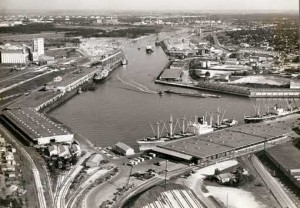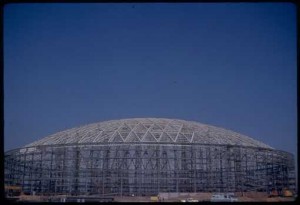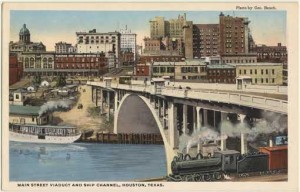
In lead up to the premiere of “The Rise and Fall of Penn Station” this evening on PBS (9pm/8pm CST), American Experience has been soliciting contributions to its Engineering Map of America. A number of academic institutions have partnered with American Experience to assemble an interactive map of some of America’s greatest engineering endeavors. Valerie Prilop, our Digital Collections Librarian, has contributed a number of resources from the University of Houston Special Collections. Today, we highlight a few of these.

Houston Ship Channel, Turning Basin, from the James H. Branard Jr. Port of Houston Collection, University of Houston Libraries’ Special Collections
The Houston Ship Channel: The Houston Ship Channel is a man-made channel for ocean-going ships that supports the Port of Houston, the nation’s busiest port in terms of foreign tonnage and the second largest petrochemical complex in the world. The channel, which officially opened on November 10, 1914, after its completion on September 7 of that year, was originally a swampy bayou and surrounding marshland with dense vegetation. Steamboats and shallow draft boats were the only vessels that could navigate the waterway and the dredging and deepening of the channel contributed greatly to the growth of Houston and Texas.
Even after its official opening, the channel continued to be widened and deepened. It now measures 45-feet deep and runs up to 530 feet in width. The entire channel stretches 52 miles from the Gulf of Mexico through Galveston Bay and up the San Jacinto River, ending less than 10 miles east of downtown Houston at the Turning Basin.

Astrodome, from the Elizabeth D. Rockwell Papers, University of Houston Libraries’ Special Collections
The Astrodome: Upon its completion in 1964, the Reliant Astrodome was the world’s first completely enclosed stadium, the first air conditioned stadium, and the largest domed structure, and when it opened as the Harris County Domed Stadium in April 1965 it was called the Eighth Wonder of the World. A major engineering challenge was how to span 642 feet, an unusually large area for a roof structure, without interior supports. The final design used a steel lamella trussed roof structure. The resulting 660-foot-wide circular roof was at the time of completion the largest self-supporting dome.

Main Street Viaduct, from the George Fuermann “Texas and Houston” Collection, University of Houston Libraries’ Special Collections
The Main Street Viaduct: From the time of its founding, Houston relied on bridges for connecting the city and allowing commerce to flourish. Buffalo Bayou, upon which the city was founded, presented a major challenge to mobility as it separated the north and south ends of the city. To answer this problem, planning started in 1911 to build a monumental bridge across Buffalo Bayou. An extension of Main Street, the bridge was to extend 1,650 feet across the water. When it was completed in 1913, the Main Street Viaduct was the largest single-arch concrete span in Texas, with the central arch measuring 150 feet. The cost of construction was a half a million dollars, and the bridge was high enough to allow for several railroad tracks to pass underneath.
View all of these and more on the Engineering Map of America!